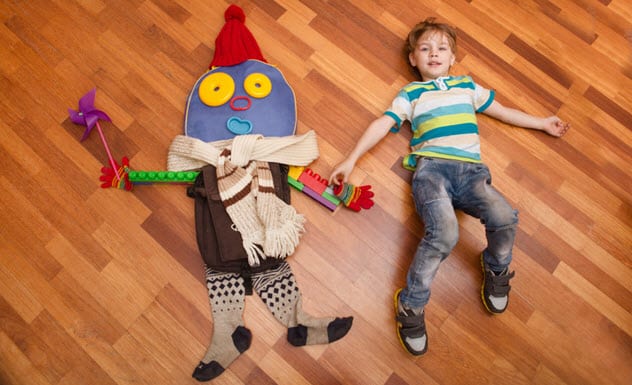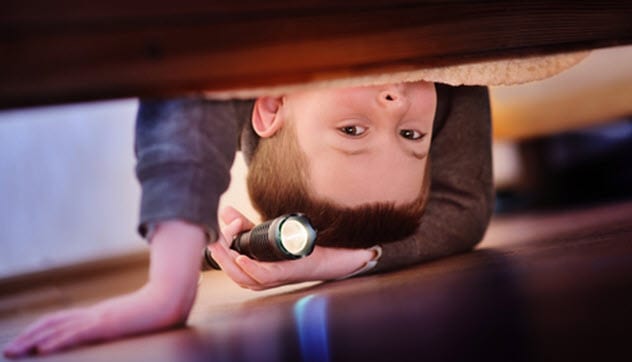 Weird Stuff
Weird Stuff  Weird Stuff
Weird Stuff  Our World
Our World 10 Ways Your Christmas Tree Is More Lit Than You Think
 Movies and TV
Movies and TV The 10 Coolest Stars to Set Sail on The Love Boat
 History
History 10 Things You Didn’t Know About the American National Anthem
 Technology
Technology Top 10 Everyday Tech Buzzwords That Hide a Darker Past
 Humans
Humans 10 Everyday Human Behaviors That Are Actually Survival Instincts
 Animals
Animals 10 Animals That Humiliated and Harmed Historical Leaders
 History
History 10 Most Influential Protests in Modern History
 Creepy
Creepy 10 More Representations of Death from Myth, Legend, and Folktale
 Technology
Technology 10 Scientific Breakthroughs of 2025 That’ll Change Everything
 Weird Stuff
Weird Stuff Ten Bizarre Facts About The Doge Meme
 Our World
Our World 10 Ways Your Christmas Tree Is More Lit Than You Think
 Movies and TV
Movies and TV The 10 Coolest Stars to Set Sail on The Love Boat
Who's Behind Listverse?

Jamie Frater
Head Editor
Jamie founded Listverse due to an insatiable desire to share fascinating, obscure, and bizarre facts. He has been a guest speaker on numerous national radio and television stations and is a five time published author.
More About Us History
History 10 Things You Didn’t Know About the American National Anthem
 Technology
Technology Top 10 Everyday Tech Buzzwords That Hide a Darker Past
 Humans
Humans 10 Everyday Human Behaviors That Are Actually Survival Instincts
 Animals
Animals 10 Animals That Humiliated and Harmed Historical Leaders
 History
History 10 Most Influential Protests in Modern History
 Creepy
Creepy 10 More Representations of Death from Myth, Legend, and Folktale
 Technology
Technology 10 Scientific Breakthroughs of 2025 That’ll Change Everything
Top 10 Things Children Do That Are Considered Insane In Adults
Childhood is often considered to be a magical time. Imagination is encouraged, and creativity is applauded. As children grow, less importance is placed on imaginative play until it is often positively discouraged when we are adults.
Many behaviors that are supported in children are viewed as mental health disorders in adults. It is thought that many adults still indulge in this kind of play but keep quiet about it out of concern that they will be considered mad.
Here are 10 common childhood behaviors that are considered mental disorders in adults.
10 Human Mental Disorders That Affect Pets Too
10 They Have Imaginary Friends

Many young children have imaginary friends. Sometimes, it is difficult to know whether they are playing “pretend” or whether they really believe that they have friends whom only they can see. These companions can be invisible friends or personified objects (like stuffed animals).
Researchers at the University of Oregon estimate that 37 percent of children have had an invisible friend by age seven. These friends can appear to be humans, animals, or even fantasy creatures. When the invisible friends are human, research has shown that boys almost always see male imaginary friends, while girls have friends of both sexes.
Although it is traditionally thought that these friends are conjured by lonely youngsters looking for companionship, this is not always the case. Many children develop good social skills as a result of their friendships.[1]
The same cannot always be said for the imaginary friends. They are sometimes naughty—not coming when they are called, for example. Also, when something has been broken or someone has made a mess, the invisible friend is often blamed for it. However, researchers discovered that even very young children were usually aware that their invisible friends were “only pretend.”
Although an imaginary friend in childhood is not a cause for concern, it can become so in adulthood, particularly when it is believed that the friend is real. Adults may act out conversations or role-play situations with a friend who is imagined. When adults talk to invisible friends whom they believe to be real, those individuals may be suffering from schizophrenia. This is particularly true when the friends talk back.
9 They Think They Can Fly

Many children report having a recurring memory of flying.
Some children can vividly describe how flying feels as well as the things that they saw and did while flying. Others develop an inner conviction that they can fly, but they have just forgotten how.
However, this belief in adults can be a symptom of psychosis. In 2013, 17-year-old Henry Kwan jumped from the top-floor balcony of his home after taking synthetic LSD. The drug induced a psychotic episode in which Kwan believed that he could fly. Despite his mother’s attempts to restrain him, Henry Kwan took off his clothes and fell from the balcony to his death.[2]
This is a particularly dangerous delusion, and sufferers are advised to seek help.
8 They Believe They Are Someone Else

It is common for a child to adopt a different persona. Role-playing can be a crucial part of a child’s development as he “tries out” different characters. Researchers have speculated that pretending to be an astronaut or a fireman, for example, can allow a youngster to practice making “predictions about others’ actions and thoughts.”
While they are playing, children often believe that they are the astronaut or the fireman. For most youngsters, their game will last only an hour or two, though some can become elaborate and last a long time.
However, when adults believe that they are someone else, it may be a sign of dissociative identity disorder (once known as “multiple personality disorder”).
It is thought that this may result from regularly repeated trauma, such as domestic violence or sexual abuse. The brain tries to protect itself by inventing another personality to gain distance from the previous painful experiences and the knowledge that they may happen again.
Studies have shown that as many as 99 percent of patients with dissociative identity disorder have experienced a pattern of recurring, overwhelming, and life-threatening events.[3]
7 They Think They Can Levitate

Many children believe that they have levitated, usually by floating down the stairs. It is not clear whether they are confusing dreams with reality or whether it is another form of fantasy. But the belief that they have levitated or can levitate is a common one in childhood.
The phenomenon has been around for a long time. Samuel Pepys even recalled an episode of childhood levitation in his diary in 1665. Then it was considered evidence of supernatural intrusion.
Adults have also experienced the illusion that they can float. Often, this takes the form of an out-of-body experience. This may manifest in an isolated episode during which a patient on an operating table floats above himself while watching the medical team working on him.
For most people, these strange episodes do not pose a threat to their overall mental health and can even be a positive experience. However, prolonged out-of-body episodes may indicate that a person is suffering from a depersonalization disorder in which he may feel disconnected from his body and thoughts.[4]
6 They Think They Are Robots

Robots hold a special fascination for children. They are intrigued by the idea of something that looks and talks like a human but isn’t. Young kids often enjoy pretending to be robots by walking like automatons and talking in stilted robotic voices.
However, some people suffering from a form of depersonalization disorder have distorted perceptions that make them feel like robots. They believe that they are not humans but rather machines without the ability to experience emotion.
The condition is often confused with depression. Although distressing, it is usually temporary. However, without treatment, the symptoms may recur.[5]
10 Strange Psychological Disorders That Will Blow Your Mind
5 They Believe They Have Special Powers

Young children often believe that they have special or secret powers. It is difficult to know whether they get this idea from movies and TV or whether it is an innate childhood belief. Some experts maintain that the superhero belief gives youngsters a sense of control and assists them in developing patience, helpfulness, and confidence in their own abilities.
However, if you believe that you have superhuman powers as an adult, it can be a sign that you are suffering from delusions of grandeur. This is recognized as delusional behavior. For example, it may take the form of believing that you are secretly the heir to the throne or a celebrity in disguise. Unfortunately, these delusions can last a long time.
One psychiatric journal reported the case of a man who was convinced for 25 years that he was “an internationally renowned secret agent” who had managed to change global military strategy when he was only eight years old. In addition, he was able to direct the maneuvers of the US Army by the power of his mind alone. Oh, and he single-handedly coordinated Kuwait’s liberation.
This man even convinced his wife and child that he was a kind of supercharged James Bond. It was considered to be a case of folie a trois, in which three individuals share the same delusional beliefs.[6]
The man claimed to have been paid over $100 million for his efforts by grateful countries. Unfortunately, when he tried to withdraw the money, the bank denied that the funds existed.
When foreign countries approached him for his intelligence-gathering abilities, he rebuffed them. In retaliation, they used their influence to refuse him planning permission on his house. At least that’s the way he saw it.
Although the delusions can seem ludicrous to outsiders, it is thought that sufferers genuinely believe them to be true. They are unable to tell the difference between fantasy and reality even while they are falsifying “proof” for the benefit of other people.
It is thought that the condition may sometimes be a symptom of schizophrenia or bipolar disorder.
4 They Do The Same Thing Repeatedly

Children like routine. It is quite common for a child to want to watch the same film, read the same book, or play with the same toy repeatedly. Younger kids can become upset quickly if their routines vary even a little bit.
Adults can also enjoy familiarity and routine. However, when the routine becomes of primary importance and disrupts normal life, it can spill over into an obsessive-compulsive disorder (OCD).
Although a child might like to listen to the same bedtime story every night because it is comforting and familiar, an adult who needs to read the same page repeatedly to make sure he hasn’t missed a bit is not likely to feel comforted.
The disorder can take up an increasing portion of each day as a sufferer repeats activities until his anxiety passes and he can move on to something else. Experts claim that these checking rituals can last up to 10 hours a day for people with severe OCD, which severely limits their life opportunities.[7]
3 They Have Night Terrors

Sometimes, children (usually between the ages of 4 and 12) experience night terrors. Although they usually remember little or nothing about these episodes, it can be distressing to witness. The terrors usually begin around 2–3 hours after the child falls asleep. The youngster may sit upright or try to get out of bed. He may scream and appear panicked. The child is also likely to be breathless, sweaty, and have a racing heart as though he has been running.
Night terrors are often temporary. Most children have only a few episodes, though it’s possible to have them more often. It is thought that the terrors usually occur if the child is overtired or sleeping in a new place.
In adults, however, night terrors can be much more serious. Those who experience such episodes are more likely to have a mood-related condition such as anxiety, depression, or bipolar disorder. A link has also been found between night terrors and post-traumatic stress disorder. Although night terrors are not thought to be dangerous, the underlying causes often require treatment.[8]
2 They Are Fussy Eaters

When babies and toddlers eat, it is common for them to develop food fads. They may often refuse to eat anything except a very small group of foods or reject anything new. This is frustrating for parents because most foods will be new when children are that young. But it is usually a phase that lasts only a few years.
Some people, however, continue to obsess about food well into adulthood. This can have a severe impact on their mental and physical health. Conditions such as anorexia and bulimia are well known, but some people may also suffer from lesser-known conditions.[9]
With rumination disorder, sufferers feel compelled to regurgitate and rechew their food. Another problem is avoidant/restrictive food intake disorder. In these cases, people do not eat enough to meet their nutritional and energy needs. However, they do not worry about their weight or body shape.
Obviously, these conditions can have a negative effect on quality of life.
1 They See Monsters Under The Bed

At some point, almost every child has been scared of monsters under the bed or in the closet. Films have been made about this subject. Despite the terror induced by movies such as Monsters, Inc., the fear that something dangerous is hiding in dark corners usually disappears by the time a child reaches puberty.
Teraphobia (the fear of monsters) is experienced by almost 100 percent of kids but relatively few adults. However, temporary teraphobia can be induced by watching scary movies or telling ghost stories, but this will generally disappear in a few days.
For some people, however, the feelings of terror persist. Like all phobias, this can begin to affect the sufferer’s quality of life. Treatment includes antidepressants and cognitive behavioral therapy.
Therapists also suggest leaving the light on.[10]
Top 10 Culture-Specific Illnesses And Mental Disorders
About The Author: Ward Hazell is a freelance writer who is also studying for a PhD in English Literature.








